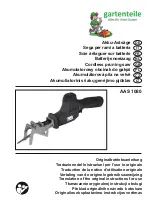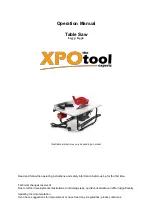
7
Palmgren Operating Manual & Parts List
83118
OPERATION (CONTINUED)
BLADE WIDTH
•
Width of blade describes distance from tip of a tooth to back of
blade.
•
Width of blade will affect rigidity of blade. A wider blade will
wander less and produce a straighter cut.
•
Width of blade also limits the smallest radius which can be cut.
A
1
/
4
” wide blade can cut about a
1
/
2
” radius.
BLADE THICKNESS
•
Blade thickness describes the distance between sides of blade.
A thicker blade has more rigidity and stronger teeth.
•
A narrow thick blade would be used to cut curves while a wide
thin blade would be used to make long, straight cuts.
BLADE PITCH
•
Pitch describes number of teeth per inch or tooth size. A blade
with more teeth per inch will produce a smoother cut.
•
The type of material being cut determines number of teeth
which should be in contact with work.
•
For soft metals, the proper blade has between 6 to 12 teeth per
inch.
•
When cutting hard metals, where shocking is more detrimental,
use a blade with 12 to 24 teeth per inch.
•
For softwoods, the proper blade has 4 to 8 teeth per inch.
•
For hardwoods, the proper blade has 8 to 12 teeth per inch.
•
There should always be at least three teeth in contact with cut
to avoid shocking blade.
•
Blade shocking occurs when pitch is too large and blade tooth
encounters too much material. This can strip teeth from blade.
•
Blade manufacturers are prepared to supply information about
blades for specific applications.
BLADE SPEED
Refer to Figure 6.
•
The amount of force with which the blade cuts is determined
by speed.
•
High cutting speeds are used on soft materials where less force
is needed and a high rate of material removal is desired.
•
Low cutting speeds are used on hard materials when more
force is required.
•
To change blade speed, position V-belt in proper configuration
(see Figure 6). Reposition and tension V-belt as described in the
next section.
45 FPM. . . . . . . . . . . . . . . . . . . . . . . . . . . . . . . . . . . . . . . . . . . . . Stainless Steel
65 FPM . . . . . . . . . . . . . . . . . . . . . . . . . . . . . . . . . . . . . . . . . . . . . . . . . . Cast Iron
90 FPM . . . . . . . . . . . . . . . . . . . . . . . . . . . . . . . . . . . . . . Tool Steel, Alloy Steel
110 FPM . . . . . . . . . . . . . . . . . . . . . . . . . . . . . . . . . . . . . . . Hard Brass, Bronze
155 FPM. . . . . . . . . . . . . . . . . . . . . . . . . . . . . . . . . . . . . . . . Soft Brass, Copper
215 FPM . . . . . . . . . . . . . . . . . . . . . . . . . . . . . . . . . . . . . . . . . . . . . . . Aluminum
REPOSITIONING V-BELT (METAL CUTTING)
Refer to Figures 6, 7 and 11.
•
Blade speed is determined by the position of the V-belt on the
idler and motor pulleys (Figure 11, Ref. Nos. 38 and 40). Blade
speed is changed by changing pulley position of V-belt.
•
Be sure to disconnect saw from power and turn saw OFF before
attempting to change blade speed.
•
To change blade speed, loosen motor mount plate (Figure 7,
Ref. No. 9) by loosening knob (Figure 7, Ref. No. 14). Position
V-belt on motor and idler pulleys as required. See Figure 6,
Blade Speeds, for recommended pulley and belt settings.
•
Tension V-belt by pushing down on motor mount plate and
tightening knob. Belt is properly tensioned when light pressure
applied to midpoint of the belt produces about
1
/
2
” deflection.
Do not over tighten V-belt.
CHANGING THE SAW OPERATION FROM METAL TO
WOOD CUTTING
Refer to Figures 2, 7, 8 and 11.
•
Remove metal cutting blade. See “Removing Blade” above.
•
Remove shroud (Figure 11, Ref. No. 48).
•
Loosen knob (Figure 7, Ref. No. 14). Remove V-belt from motor
and idler pulleys (Figure 11, Ref. Nos. 38 and 40).
•
Place V-belt on motor and drive pulleys (Figure 8, Ref. Nos. 46
and 50).
•
Tension V-belt by pushing down on motor mount plate and
tightening knob. Belt is properly tensioned when light pressure
applied to midpoint of the belt produces about
1
/
2
” deflection.
•
Change clutch handle from “metal” to “wood”. (Refer to Figure 2)
•
Replace shroud.
•
Install wood cutting blade. See “Installing Blade”, page 6.
Properly tension, track and adjust blade guides before opera-
tion.
CHANGING THE SAW OPERATION FROM WOOD TO
METAL CUTTING
Refer to Figures 2, 7, 8 and 11.
•
Remove wood cutting blade. See “Removing Blade” above.
•
Loosen knob (Figure 7, Ref. No. 14). Remove V-belt from motor
and drive pulleys (Figure 8, Ref. Nos. 46 and 50).
•
Remove shroud (Figure 11, Ref. No. 48).
•
Place V-belt on motor and idler pulleys (Figure 11, Ref. Nos. 38
and 40).
•
Tension V-belt by pushing down on motor mount plate and
tightening knob. Belt is properly tensioned when light pressure
applied to midpoint of the belt produces about
1
/
2
” deflection.
•
Change clutch handle from “wood” to “metal”. (Refer to Figure 2)
•
Replace shroud.
•
Install metal cutting blade. See “Installing Blade”, page 6. Properly
tension, track and adjust blade guides before operation.
L
H
High Range
L
H
Low Range
110 FPM
155 FPM
215 FPM
45 FPM
65 FPM
90 FPM
Figure 6 - Blade Speeds








































